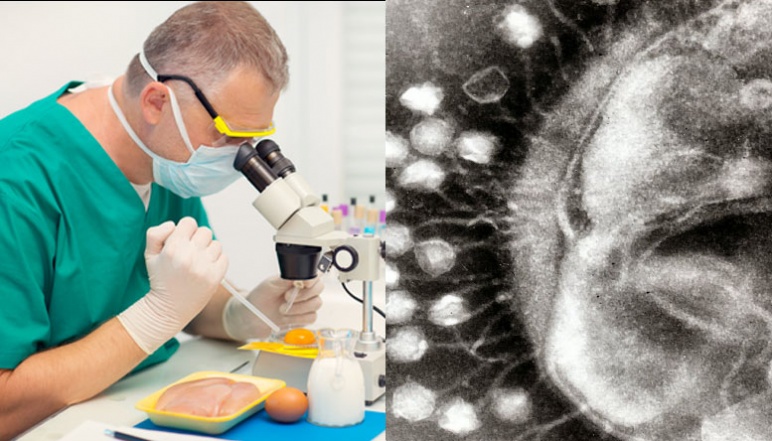Our Research Real-time, on-site detection of foodborne pathogens by engineered bacteriophage integrated with microfluidic sample preparation platforms

Photo Credit:iStock Images
Principal Investigators
Jongyoon Han
- Professor of Electrical Engineering
- Professor of Biological Engineering
- Department of Electrical Engineering and Computer Science
- Department of Biological Engineering
Timothy Lu
- Associate Professor
- Department of Electrical Engineering and Computer Science
- Department of Biological Engineering
Challenge:
Current food safety testing is time intensive, costly, and needs to be done in a lab. Can we engineer a fast and accurate test that can be performed on site?
Research Strategy
- Used microfluidics to amplify sample testing efficiency
- Engineered pathogen-targeting viruses to induce bioluminescence in harmful bacteria in a sample
- Measured light produced by virus-infected cells to determine contamination level
Project description
Bacterial contamination and infection are a significant problem to public health, food, industry, environmental biosafety, and many other areas. However, current methods for detecting bacteria in medical, veterinary, agricultural, food processing, industrial and other contexts are slow, require specialized personnel or equipment to execute, and are often expensive. These drawbacks result from the need to overcome the following challenges: 1) separating bacteria from the sample matrix to prevent interference from the matrix and competing non-pathogenic bacteria present in the sample, 2) achieving sufficient signal from the analyte over background noise, and 3) discriminating live from dead bacteria. In order to overcome these hurdles, current methods for bacterial pathogen detection in the food industry rely on an enrichment step (or steps) to increase the number of target pathogen cells over the background microbial flora. Thus, current processes require a large time lag between sampling and final readout, during which time the sampled conditions may have changed and the results of the assay cannot be confidently utilized to act on contamination in already widely distributed food products. As a result, significant economic costs are incurred by the food industry due to frequent and expensive recalls and public health is affected by unpredictable outbreaks in the food supply. There is a large unmet need for technologies that can provide quick, sensitive, and specific detection of foodborne pathogens to enable proactive, convenient, and rapid food safety programs that reduce costs and threats to human health.
The research team of this project developed a technical solution that enables near-real-time, on-site, specific, sensitive, easy-to-use, and point-of-care diagnostics for microbial pathogens, which can be directly implemented in food-related industries. They combined a powerful microfluidics-enabled concentration and separation platform for sample preparation that led into a downstream detection step using pathogen-specific bacteriophages that are engineered to provide highly sensitive and specific detection of target bacteria. The microfluidic sample preparation platform concentrated bacteria and separated them from the sample matrix, thus minimizing matrix interference, removing the need for high sample dilution, and making it even easier for the downstream bacteriophage-based assay to achieve microbial detection. The phages had natural specificity towards target microbial pathogens and could readily distinguish between pathogens and other microbial flora. The phages were genetically engineered to strongly express a highly active form of luciferase once they had infected a target pathogen, which produced photons that were easily detected with a luminometer as a marker of pathogen presence. The team’s integrated platform was highly flexible, supported by strong preliminary data, and could be optimized for a wide range of foods (e.g., milk, meat, vegetables) that pose a broad spectrum of technical challenges. In summary, the transformative technologies resulted in pathogen diagnostic assays that require minimal enrichment, thus speeding the time-to-detection, and that are easy to use and do not require technically sophisticated operators to run, thus facilitating widespread adoption in the food safety industry and eventually other areas of high importance (water, clinical, oil and gas, etc.).
Outcomes
- Built bacterial concentration system prototype that is able to concentrate 99% of bacteria in 100mL of water allowing for faster identification of pathogens
- Developed method to engineer bacteriophage to encode reporter genes for phage-based detection
- Displayed accurate detection of bacteria using both bacterial concentration and phage-based detection system
Publications
Phage-based applications in synthetic biology
Sebastien Lemire, Kevin M. Yehl, and Timothy K. Lu, Annual Review of Virology, 2018
Additional Details
Impact Areas
- Food
Research Themes
- Sensors & Monitoring
- Transforming Food Systems
Year Funded
- 2016
Grant Type
- Seed Grant
Status
- Completed


